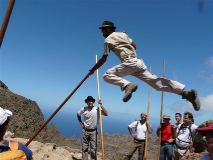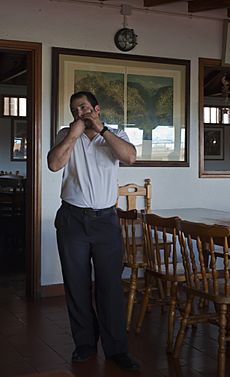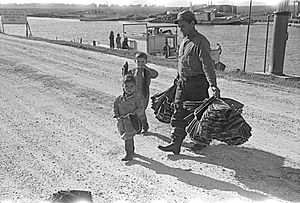Canary Islanders facts for kids
| Total population | |
|---|---|
| c. 1,600,000 | |
| Regions with significant populations | |
72.1% of the total Canary Islands population |
|
| Significant Canary Islander diaspora in | |
| Total unknown | |
| 42,671 | |
| 40,602 | |
| 2,390 | |
| 1,600 | |
| Languages | |
| Canarian Spanish, Silbo Gomero | |
| Religion | |
| Predominantly Roman Catholic (85%) |
|
| Related ethnic groups | |
| Isleños, other Spaniards, Madeirans, Portuguese, Berbers (Guanches) | |
Canary Islanders, also called Canarians (Spanish: canarios), are the people who live in the Canary Islands. These islands are an autonomous community of Spain. They are located off the coast of northwest Africa.
People in the Canary Islands speak a special kind of Spanish language. It is known as Canarian dialect. Canarians and their families have played a big part in the history of many countries in Latin America. You can still see their culture strongly in places like Uruguay, Venezuela, Cuba, the Dominican Republic, and Puerto Rico.
Contents
History of the Canarian People
The first people to live in the Canary Islands were called the Guanches. They likely came from the Berber peoples of North Africa.
Spain began to take over the islands in the early 1400s. They slowly took control of the native Guanche people. The Guanches were eventually absorbed into the new population. Today, studies of Canarian genes show a mix of European and North African roots.
After more Europeans settled there, the Guanches became part of the new culture. Their original way of life mostly disappeared. A leader named Alonso Fernández de Lugo brought many new settlers to the islands. These settlers came from Spain and Portugal between the late 1490s and 1520s.
Canarian Culture and Traditions
Modern Canarian culture is mostly Spanish. But it still has some influences from the old Guanche ways.
Traditional Sports and Communication
Some traditional Canarian sports come from Guanche culture. These include lucha canaria (Canarian wrestling) and juego del palo (stick game). Another is salto del pastor (shepherd's jump).
Other traditions include Canarian pottery. There are also many Guanche words used in the local Spanish language. People in the countryside still enjoy guarapo gomero and gofio.
On the island of La Gomera, people use a special way to talk across deep valleys. It is a whistled speech called Silbo Gomero. This whistle language can be heard up to 3 kilometers (1.9 miles) away. The Guanches created this unique language. Spanish settlers learned it in the 1500s. It was also once used on El Hierro, Tenerife, and Gran Canaria.
Canarian Festivals and Celebrations
The Canary Islands celebrate many holidays. Some are international or national. Others are special to the region or individual islands.
Canary Islands Day is the official holiday for the region. It is celebrated on May 30th. This day marks the first meeting of the Parliament of the Canary Islands in 1983.
The most famous festival is the carnival. Carnivals are held on all islands and in all towns. The biggest ones are in Santa Cruz de Tenerife and Las Palmas de Gran Canaria. These street parties happen between February and March. Other islands have their own unique carnival traditions. These include the Festival of the Carneros in El Hierro and the Festival of the Diabletes in Teguise in Lanzarote.
Latin American Influence
Canarian culture has a strong influence from Latin America. This is because many Canarians moved to countries like Puerto Rico, Cuba, the Dominican Republic, and Venezuela. They also went to parts of the US, like Louisiana and Texas. This back-and-forth movement over centuries shaped the culture.
Religion in the Canary Islands
Most Canary Islanders are Roman Catholic. There are also smaller groups of other Christian faiths.
The Virgin of Candelaria is the Patron of the Canary Islands. Her appearance is said to have helped the islands become Christian. Two Catholic saints were born in the Canary Islands. They are Peter of Saint Joseph de Betancur and José de Anchieta. Both were born on Tenerife. They became missionaries in Guatemala and Brazil.
The Canary Islands have two Catholic areas, each led by a bishop:
- The Diócesis Canariense covers Gran Canaria, Fuerteventura, and Lanzarote.
- The Diócesis Nivariense covers Tenerife, La Palma, La Gomera, and El Hierro.
Around 5 percent of Canarians follow other religions. There is a group of Muslims, mostly people born outside Spain. There are about 70,000 Muslims and 40 mosques in the islands. The Islamic Federation of the Canary Islands supports the Muslim community.
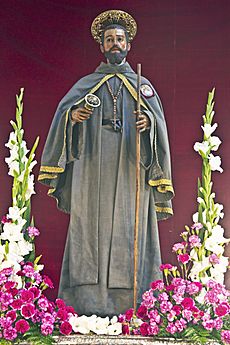
Religious Beliefs (2012)
A study from 2012 showed the following beliefs:
- Catholic: 84.9%
- Atheist/Agnostic/Unbeliever: 12.3%
- Other religions: 1.7%
Among those who believe, 38.7% attend religious services often.
Canarian People Around the World
For a long time, the Canary Islands were a link between Spain and the Americas. Because of this, many Canarians moved and settled in the New World. This started as early as the 1400s. They mainly went to Cuba, Puerto Rico, the Dominican Republic, Colombia, Venezuela, and Uruguay.
Who Lives in the Canary Islands?
The population of the Canary Islands includes people who have lived there for a long time. It also includes new people from mainland Spain. These include people from Andalusia, Galicia, and Catalonia. There are also older settlers from Portugal, Italy, the Netherlands, Britain, and France. More recently, people from other countries have arrived.
In 2019, the total population was 2,153,389 people. About 72.1% were native Canary Islanders. A total of 80.6% were born in Spain. The other 19.4% were born outside Spain. Most of these foreign-born people are from the Americas. Many are from Venezuela (66,573) and Cuba (41,792). There are also people from Africa, mostly Morocco (24,268).
Population History
| Population history | ||
|---|---|---|
| Year | Population | |
| 1768 | 155,763 | |
| 1787 | 168,928 | |
| 1797 | 173,865 | |
| 1842 | 241,266 | |
| 1860 | 237,036 | |
| 1887 | 301,983 | |
| 1900 | 364,408 | |
| 1920 | 488,483 | |
| 1940 | 687,937 | |
| 1960 | 966,177 | |
| 1981 | 1,367,646 | |
| 1990 | 1,589,403 | |
| 2000 | 1,716,276 | |
| 2010 | 2,118,519 | |
| 2011 | 2,082,655 | |
| 2019 | 2,152,590 | |
Where People Were Born (2019)
| Population of the Canary Islands 2019 | |||
|---|---|---|---|
| Birthplace | Population | Percent | |
| 1,553,517 | 72.1 | ||
| Other regions (Spain) | 176,302 | 8.2 | |
| Total, Spain | 1,735,457 | 80.6 | |
| Foreign-born | 417,932 | 19.4 | |
| Americas | 201,257 | 9.3 | |
| Venezuela | 66,573 | - | |
| Cuba | 41,792 | - | |
| Colombia | 31,361 | - | |
| Argentina | 17.429 | - | |
| Uruguay | 8,687 | - | |
| Rest of Europe | 154,511 | 7.2 | |
| Italy | 39,469 | - | |
| Germany | 25,921 | - | |
| United Kingdom | 25,339 | - | |
| Africa | 38,768 | 1.8 | |
| Morocco | 24,268 | - | |
| Asia | 23,082 | 1.1 | |
| China | 9,848 | - | |
| Oceania | 314 | 0.0 | |
| Total | 2,153,389 | 100.0% | |
| Source | |||
Canarian Identity
A 2012 study asked people in the Canary Islands about their national identity. Most (49.3%) felt equally Spanish and Canarian. About 37.1% felt more Canarian than Spanish. Only 6.1% felt only Canarian.
| National Sentiment in the Canary Islands | |||
|---|---|---|---|
| Only Spanish | 3.5% | ||
| More Spanish than Canarian | 2.0% | ||
| Equally Spanish and Canarian | 49.3% | ||
| More Canarian than Spanish | 37.1% | ||
| Only Canarian | 6.1% | ||
| Did not answer | 2.0% | ||
Famous Canarians
Many famous people come from the Canary Islands. Here are a few:
- Javier Bardem, a well-known actor.
- José de Anchieta, a Jesuit priest and saint who was a missionary in Brazil.
- Peter of Saint Joseph Betancur, a saint and missionary in Guatemala.
- Amaro Pargo, a famous corsair (a type of privateer or pirate).
- Benito Pérez Galdós, a famous writer.
- César Manrique, a well-known artist.
- David Silva, a famous football (soccer) player.
- Pedro, another famous football (soccer) player.
- Agustín de Betancourt y Molina, an engineer and Russian General.
- Manolo Blahnik, a famous fashion designer.
- Alfredo Kraus, a well-known opera singer.

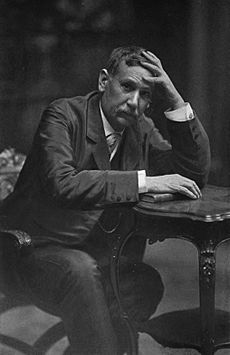
See also
 In Spanish: Pueblo canario para niños
In Spanish: Pueblo canario para niños
- Canarian dialect
- Guanche language
- Isleños
- Nationalities in Spain


